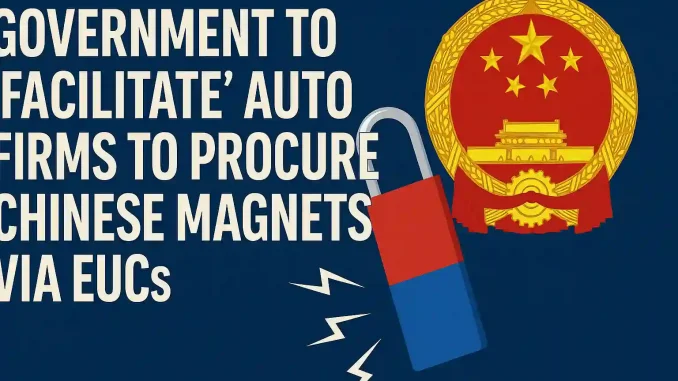
In a significant move to support India’s rapidly growing electric vehicle (EV) and automotive manufacturing sectors, the central government has announced its intent to “facilitate” the procurement of Chinese-origin magnets by domestic automakers through the use of End Use Certificates (EUCs). This development comes amid rising concerns over supply chain disruptions, critical material shortages, and the global dependence on China for rare earth components, particularly permanent magnets used in EV motors and hybrid systems.
The decision marks a pragmatic policy shift that seeks to balance India’s ambition for self-reliance in manufacturing (Atmanirbhar Bharat) with the realities of current global trade dependencies, especially in sectors critical to India’s green transition.
What’s Driving the Move?
1. China’s Monopoly on Rare Earth Magnets
China is the world’s largest producer of rare earth elements, accounting for over 90% of global production of neodymium-iron-boron (NdFeB) magnets, which are critical for high-performance motors used in electric vehicles, wind turbines, and consumer electronics.
These magnets play an indispensable role in traction motors that power EVs, offering high torque, energy efficiency, and compact form factors. While global automakers have diversified sourcing in recent years, Chinese suppliers remain the most reliable and cost-effective source for these materials.
2. India’s Domestic Production Gap
Despite ambitious plans, India currently lacks sufficient domestic capacity for manufacturing high-grade rare earth magnets. While entities like IREL (India) Limited and the Defence Research and Development Organisation (DRDO) have begun pilot projects for magnet production, commercial-scale availability remains several years away.
In the interim, auto firms—especially EV startups and Tier-1 component suppliers—are dependent on imports, most of which indirectly originate from China. With new licensing norms and geopolitical tensions complicating direct imports, this has led to bottlenecks in supply and rising input costs.
Role of EUCs (End Use Certificates)
To address the concerns of national security, dual-use technology risks, and strategic misuse, imports of certain sensitive materials—including high-grade magnets—require End Use Certificates (EUCs) under India’s foreign trade policy.
The government’s new facilitative approach would involve:
- Streamlining EUC issuance through a central portal or nodal agency.
- Ensuring timely approvals for genuine industrial use by vetted auto manufacturers.
- Possibly pre-clearing vendor lists or routes to avoid undue delays in customs clearance.
- Avoiding blanket bans or overregulation that could hamper critical industries.
This move is not about relaxing controls, officials clarify, but about enabling smoother transactions within a robust compliance framework.
Industry Reactions: Relief Mixed with Caution
Auto manufacturers, particularly those in the electric and hybrid segments, have welcomed the move.
Maruti Suzuki, which is preparing to launch its first fully-electric model in 2025, noted that the “availability of critical components like permanent magnets is essential to ensure our product roadmap is not delayed.”
Tata Motors, a leader in the Indian EV market, emphasized that “predictable and frictionless access to global supply chains is vital at this stage of industry transition.”
At the same time, some industry leaders have urged for clarity on:
- The duration of this facilitation window.
- Whether quantitative caps will be imposed.
- How the government will differentiate strategic vs. commercial applications.
There are also concerns about cost escalations, as Chinese manufacturers continue to control global pricing, and about currency fluctuation risks.
Balancing Act: National Security vs Industrial Growth
The facilitation of Chinese magnet imports presents a complex dilemma for Indian policymakers. On one hand, there’s a strategic imperative to reduce dependence on China for critical materials. On the other, India’s green energy transition and industrial expansion cannot be put on hold due to current infrastructure gaps.
By allowing regulated imports under the EUC framework, the government is trying to create a bridge policy—one that supports industrial continuity without compromising national security.
A senior official from the Ministry of Commerce and Industry stated:
“We’re not liberalizing controls. We are enabling compliance to work efficiently. The auto industry is strategic, and we are ensuring they are not deprived of what they need to remain globally competitive.”
The Push for Indigenous Capability
While short-term facilitation is critical, the move is also a wake-up call for India to accelerate its domestic magnet manufacturing ecosystem. In recent years, several steps have been initiated:
- The Department of Science and Technology has funded magnet R&D programs.
- Startups and PSUs are exploring rare earth recycling from e-waste and industrial scrap.
- Collaborations with countries like Australia and Japan are being explored for rare earth ore sourcing and technology transfer.
A high-level inter-ministerial group is reportedly drafting a National Magnet Strategy, which will outline a roadmap for achieving self-reliance by 2035.
The Global Context: A Fragile Supply Chain
India’s challenge is not unique. The U.S., EU, Japan, and South Korea are all actively working on de-risking supply chains for rare earth materials. The Russia-Ukraine war, COVID-19 aftershocks, and U.S.-China trade tensions have underscored the fragility of global component dependencies.
Some global players, including Tesla and GM, are developing magnet-free electric motors or exploring alternative materials like ferrite. However, these technologies are still nascent and may not match the performance metrics of NdFeB magnets in the short term.
Leave a Reply